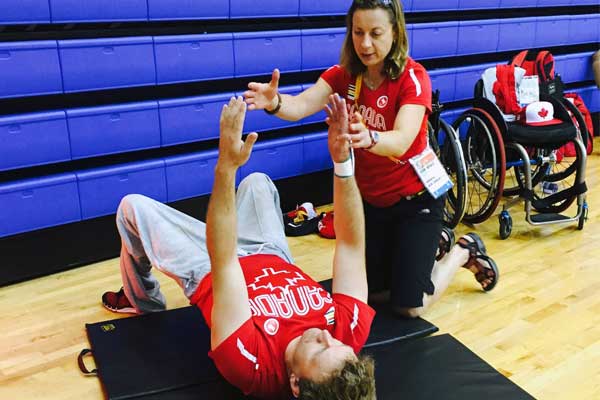
Behind the scenes at the Parapan Am Games: U of T physiotherapist Agnes Makowski
Published: August 12, 2015
All athletes require the services of health professionals. Some inspire special devotion.
“The Parapan Am Games are unique in that the athletes are competing with a variety of physical conditions,” says physiotherapist Agnes Makowski, an adjunct lecturer in the University of Toronto’s department of physical therapy.
Makowski is one of dozens of U of T health care experts – family physicians, orthopedic surgeons, athletic therapists, nurses and dietitians – who have served on the sidelines and in the backrooms of the Toronto 2015 Pan Am/Parapan Am Games.
Her position this week is medical lead for the Canadian men’s wheelchair basketball team, an impressive squad that outscored the competition 176 to 82 in its first two outings.
That kind of performance entails physiotherapy at a high level. Think of employing all the skill you have learned in school and on the job and taking it up a notch.
The range of Parapan needs is wide. Some athletes are dealing with visual dysfunction, others have impairments as a result of spinal cord injury. There are survivors of cancer who function as amputees and athletes who are born with congenital anomalies, such as spina bifida.
Spectators of wheelchair basketball naturally focus their attention on the tremendous arm strength and mobility of these athletes. But players with spinal cord injuries can develop back pain as a result of prolonged sitting.
Recovery time away from the sports chair is important, as are manual therapy, accupuncture and traction. Makowski adapts techniques and positions to each player, taking into consideration their impairments and whether they have metal hardware in their spines.
Other common ailments of high-performing wheelchair athletes are neck pain and injuries to the upper extremities such as rotator cuff impingement. No case is exactly the same.

“We do our best to look at each individual athlete and consider current health status, extent of disability and how we can maximize their performance through injury prevention,” Makowski says. “We give them training recommendations about their wheelchair seating and monitoring of their injuries.”
U of T has played a major role in the development of parasport through the Wheelchair Basketball Canada National Academy, which is based at the Toronto Pan Am Sports Centre at U of T Scarborough.
Makowski worked as a Team Canada physiotherapist during the Pan Am Games, but to return to the Parapan Am Games represents another level of commitment.
“The challenges for physiotherapists and other health care providers are to consider the individual athlete and focus on optimizing ability,” Makowski said. “We see athletes use sport to overcome impairments, and then compete at the highest levels.”



